Rambo TV Games (Atari 2600) [article with a bunch of photos and a drop of video]
In 1977, Atari released the Atari Video Computer System home gaming console. It was one of the first mass-sold consoles with cartridges on which full-fledged programs were recorded.
In 1982, the next edition was released, with which the console received the more popular name today - Atari 2600 . However, in our country, the acquaintance with this console most likely happened not with one of the original versions, but with the Taiwanese Rambo clone. We will talk about him today ...

')
Briefly about the main characteristics of the console ... About which you probably have already heard dozens of times. But for the pro forma it is necessary to list, but what is the article about retro-iron without tsiferok?
As you can see, the list lacks such a thing as video memory. It's all about a fairly specific graphics chip device, about which, if desired, you can write a separate article ... In any case, programming for such restrictions is also a task.
This is enough theory - go to the practice. The console box is huge, I would even say gigantic, it is almost the same size as the Power Macintosh, which I mentioned earlier . Fortunately, despite its size, it weighs much less.


On the top cover of the box you can see the joyful inscription "2600 built-in games", which, of course, is full of bullshit. In addition, none of the games on the cover in this console is not built, but more on that later.
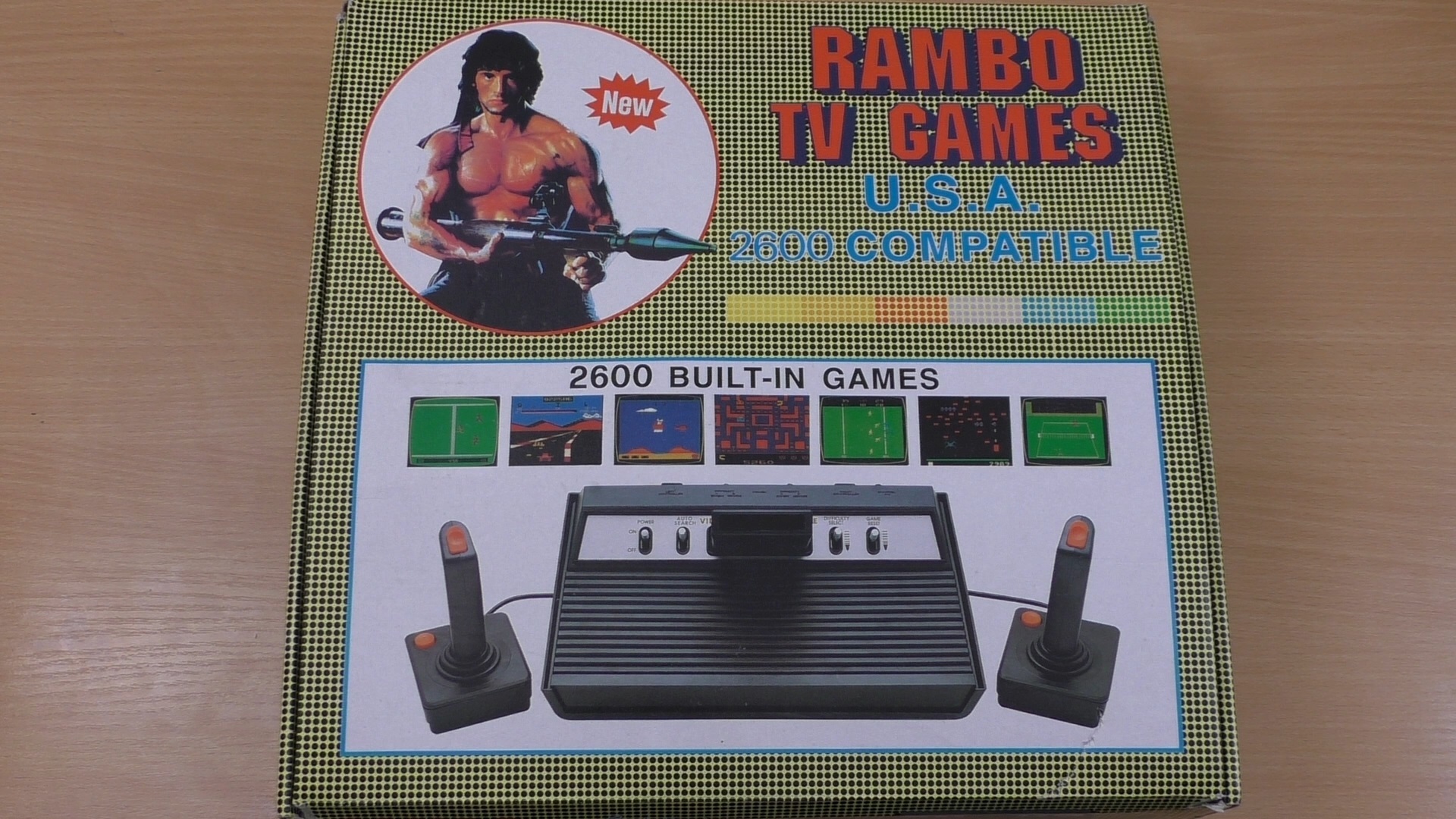
The contents of the box traditionally begin with the documentation. Here it is represented by exactly one A4 sheet, where all the necessary things are indicated in two languages - English and Arabic.
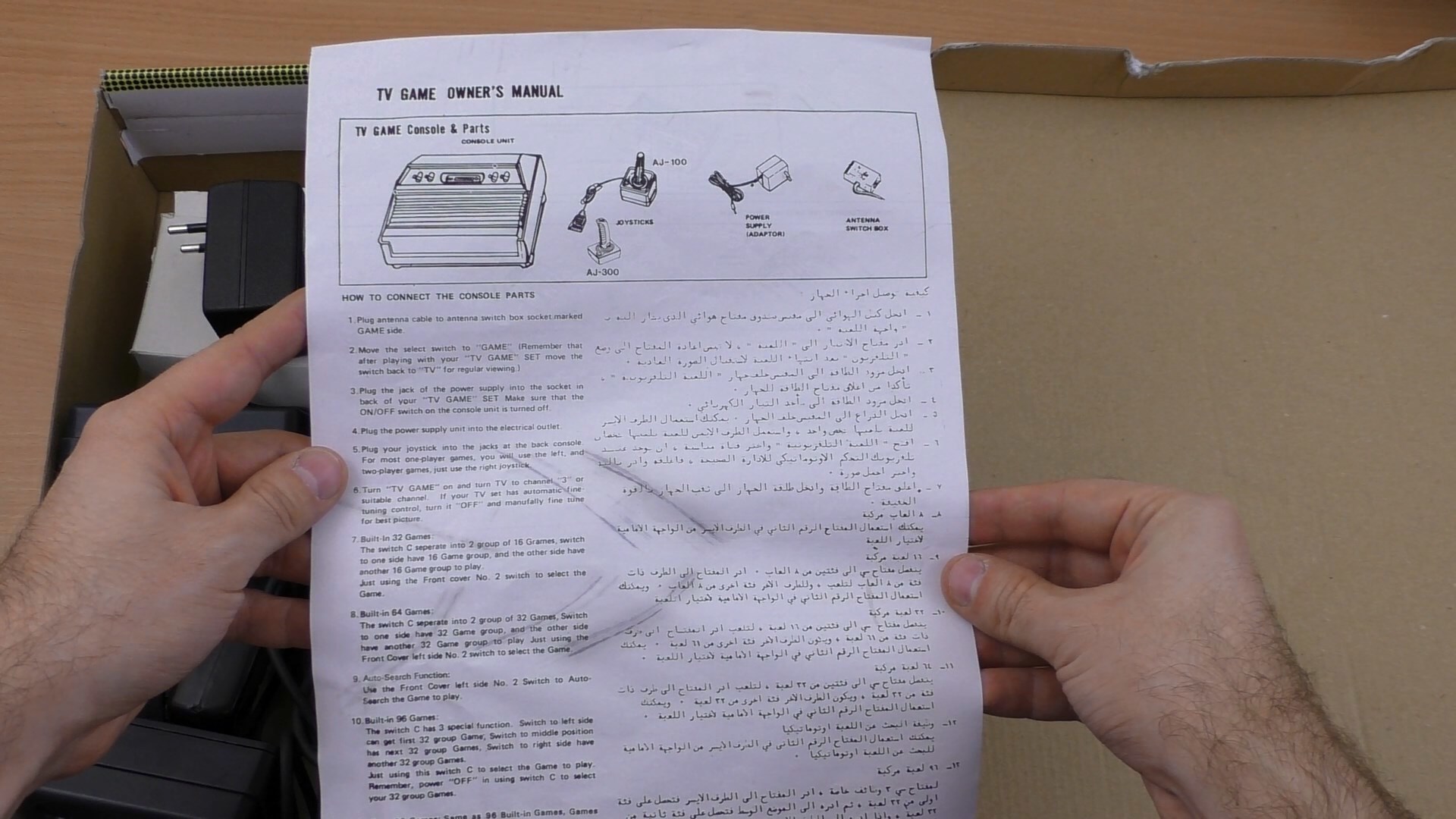

The next thing in the box is the power supply. A rather typical unit, although I personally was a little surprised by the connector, made in the shape of a 3.5 mm jack. Of course, I heard about this, but I never saw it live.
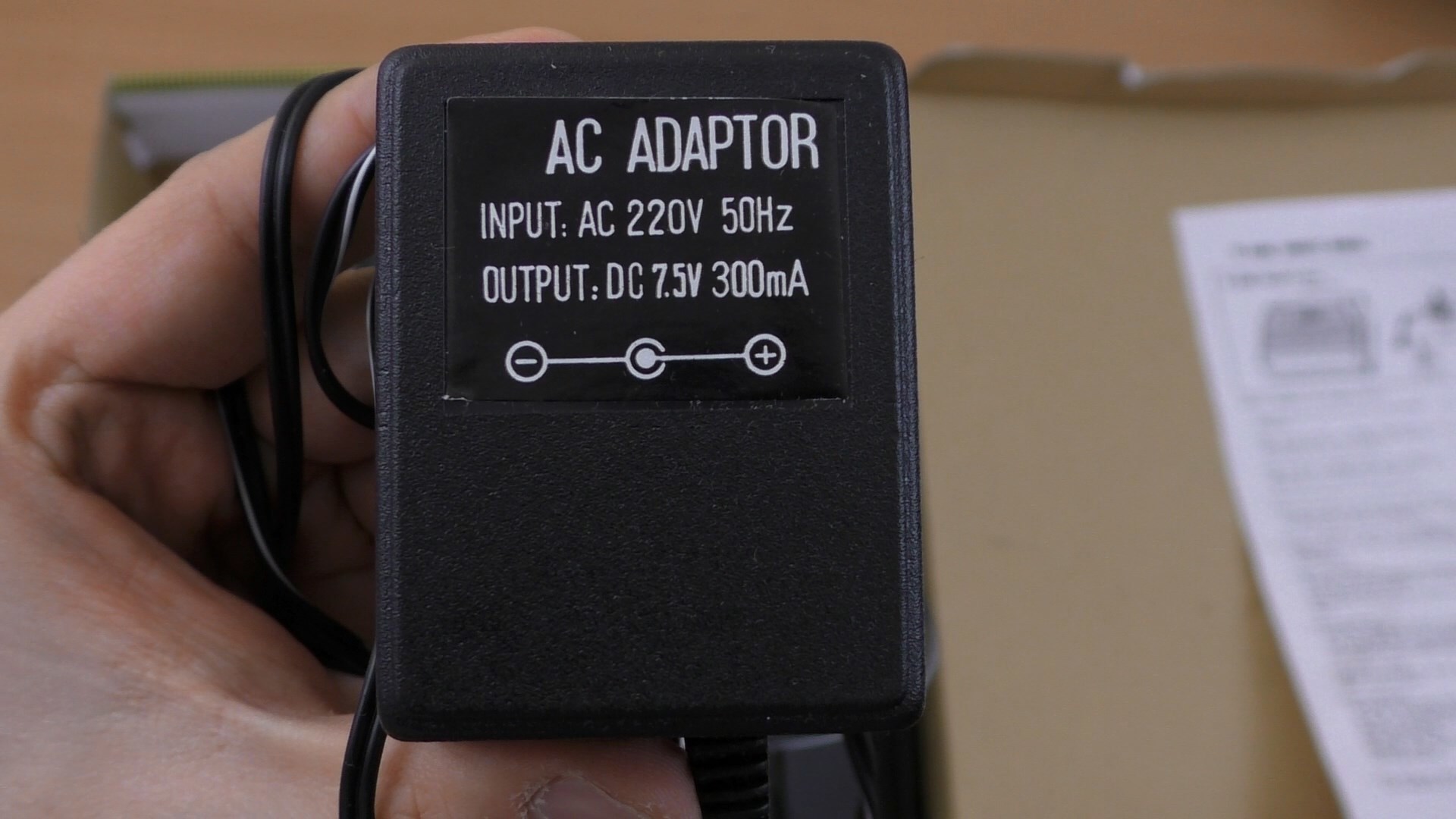
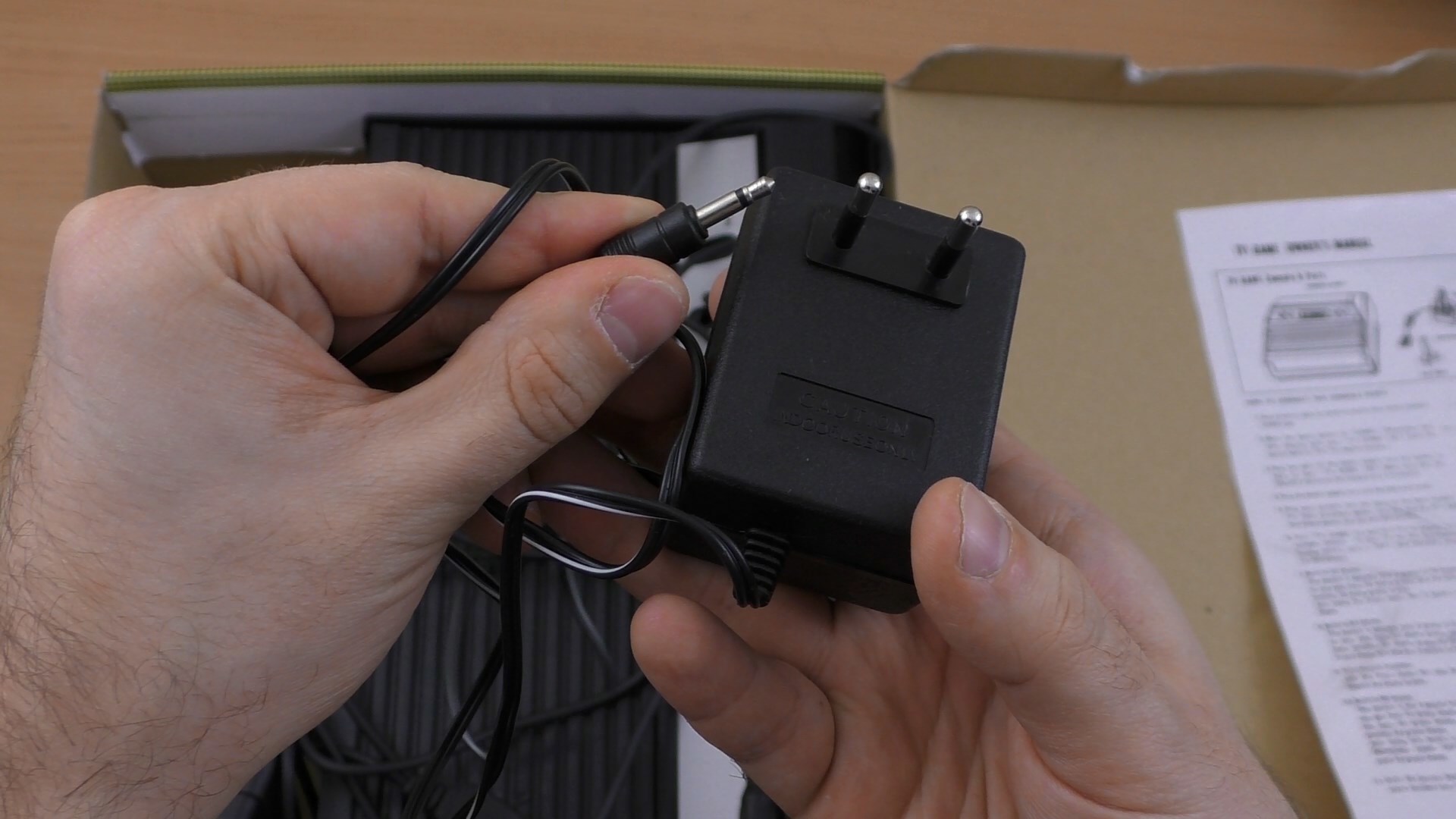
Next comes a pair of joysticks, and personally only one of them worked normally for me, the second one has contacts that go around, and there are purely mechanical damage inside. It is curious that the standard Atari joystick had only one button, on the base, this one has two of them at once. These two buttons duplicate each other, but I want to pay tribute to the Chinese - in my opinion, pushing the handle button is much more convenient than the button at the bottom. However, everything is to your taste - both buttons are pressed well.
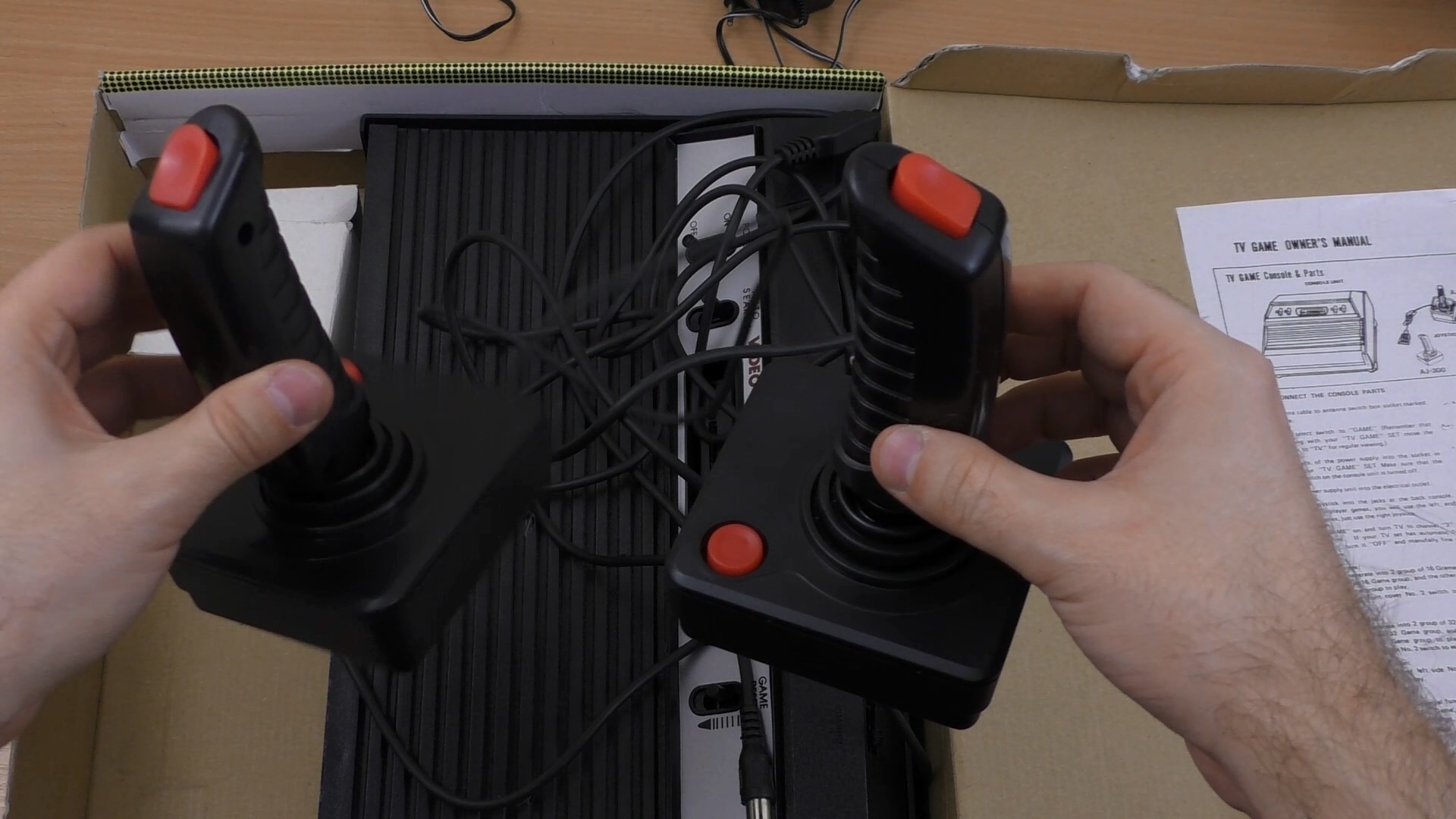

If you disassemble the joystick, you can find that it is not analog, but discrete, i.e. does not measure the force of deflection in any direction. Contact or is, or not, without variations and intermediate values. Original joysticks work similarly, except that they are assembled with higher quality.

The next thing in the box is the antenna input splitter. We need it in order to plug into the TV at the same time and the console, and the usual antenna, getting the opportunity to switch between them, without pulling the antenna cable back and forth. This switch is purely mechanical, simply closing the desired pair of connectors
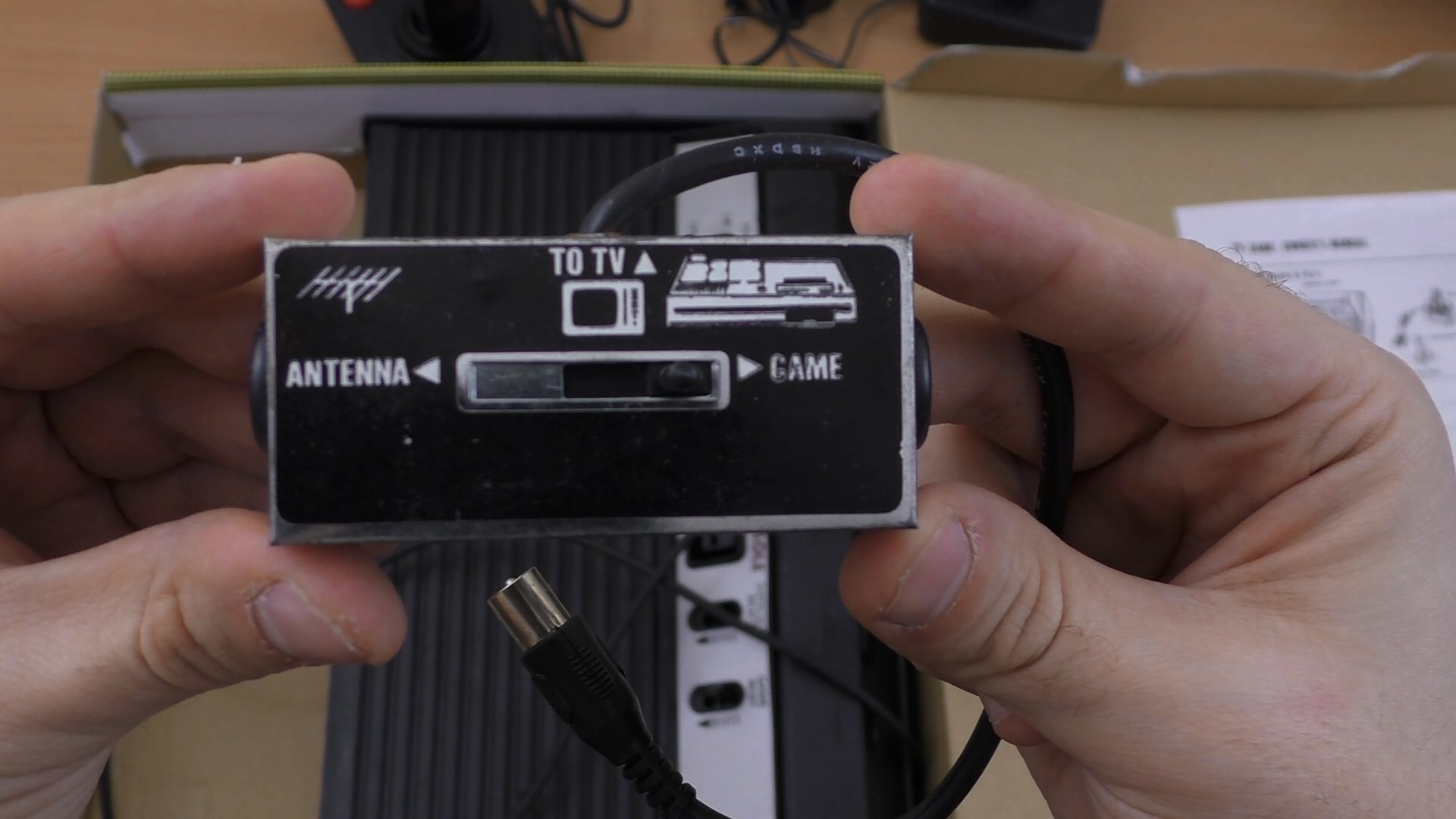
Well, now - the console itself.
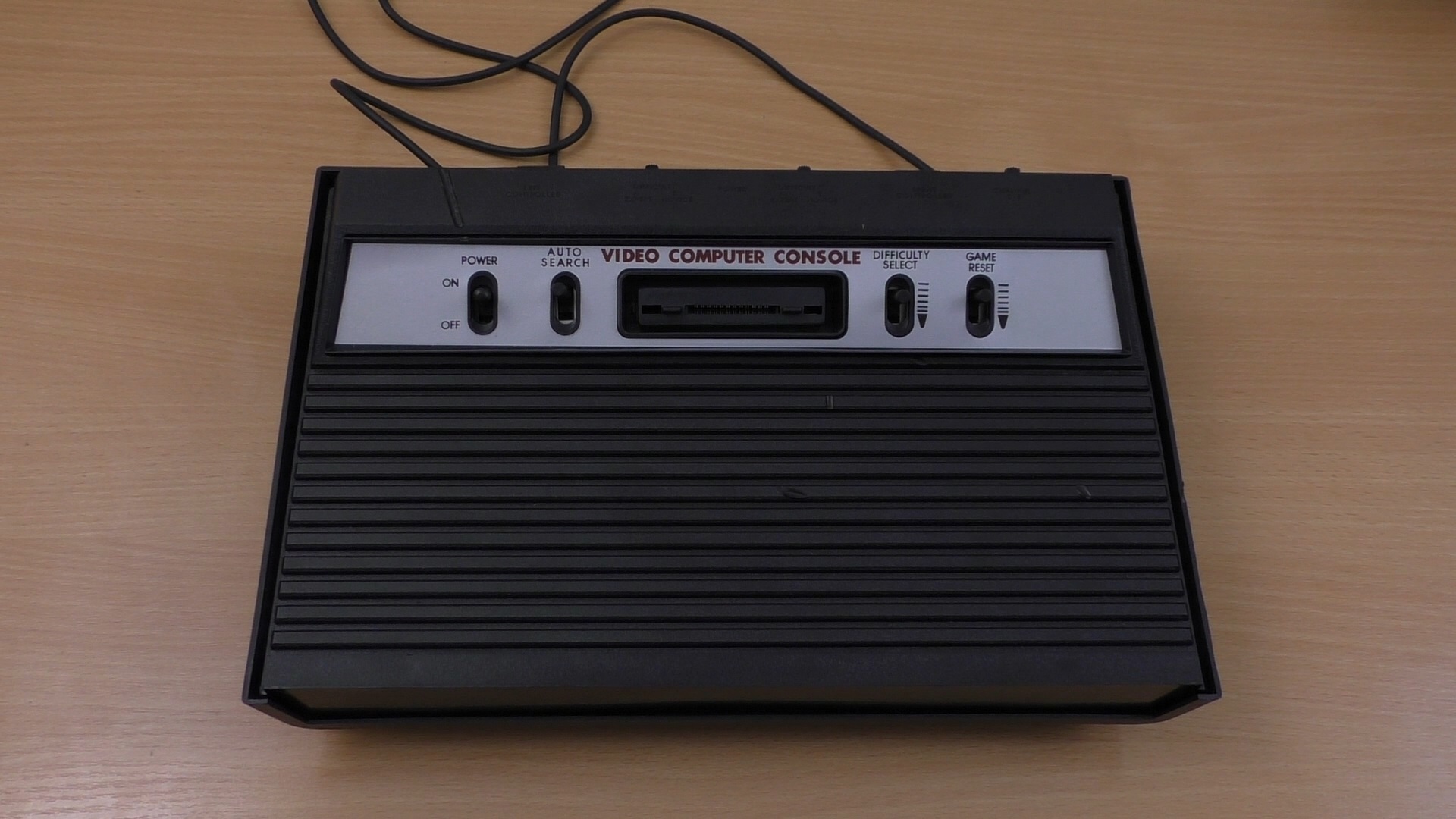
This console, like its box, is very large, compared to it, the late edition of PlayStation One is just a little one. By the way, I already shot a separate video about the first PlayStation. As well as about the PlayStation 2, but she’s definitely not to do with it at all ...
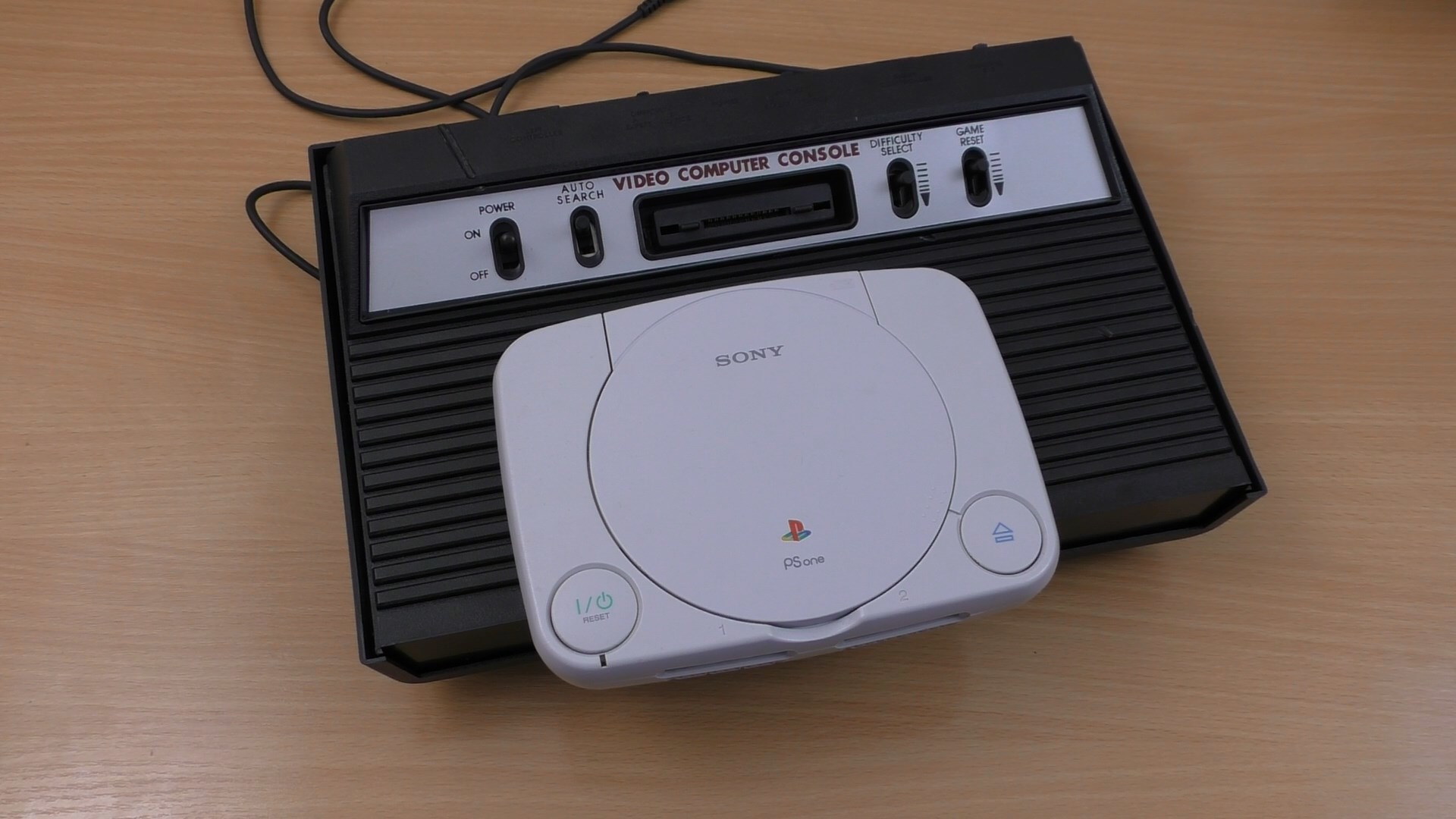
At first glance, the console is very much like the original, and not at the earliest, but at a later and more familiar version of the console. But there are a number of differences. Firstly, of course, there are no Atari logos, and a different inscription is used, instead of the Video Computer System, we see the Video Computer Console - it seems to be enough to be confused.
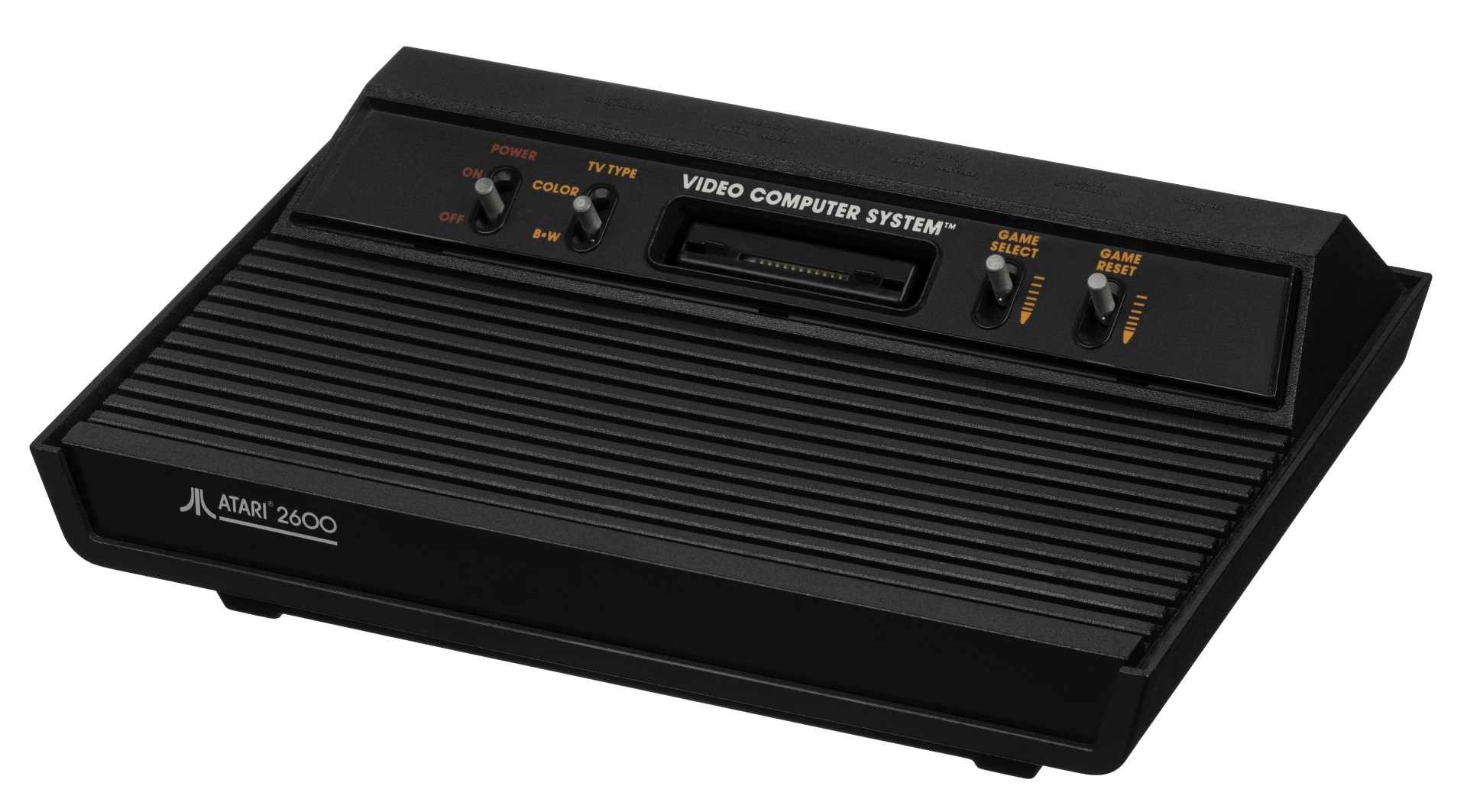
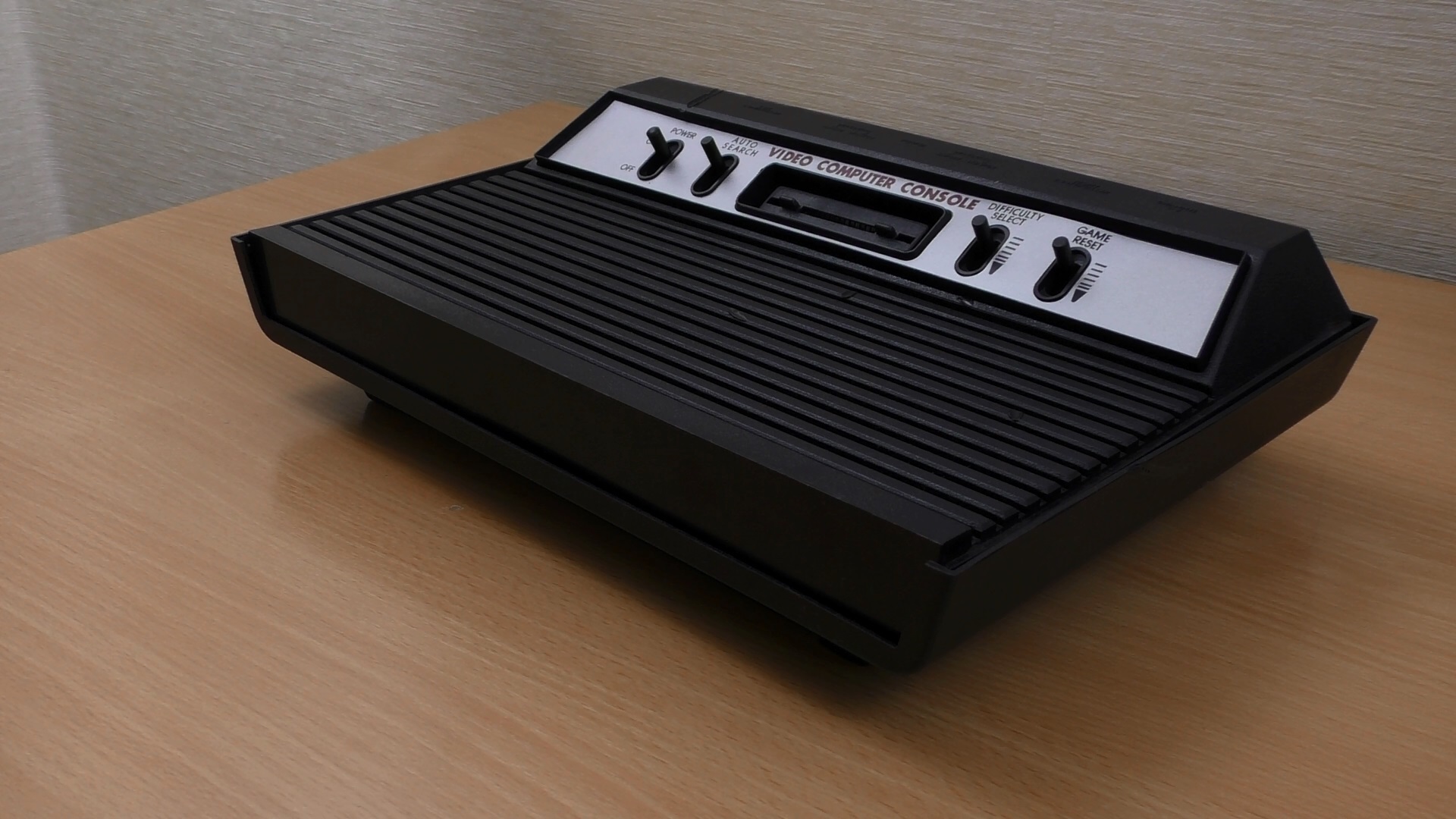
Secondly, reddish and switches. From above - a clone, from below - the original.
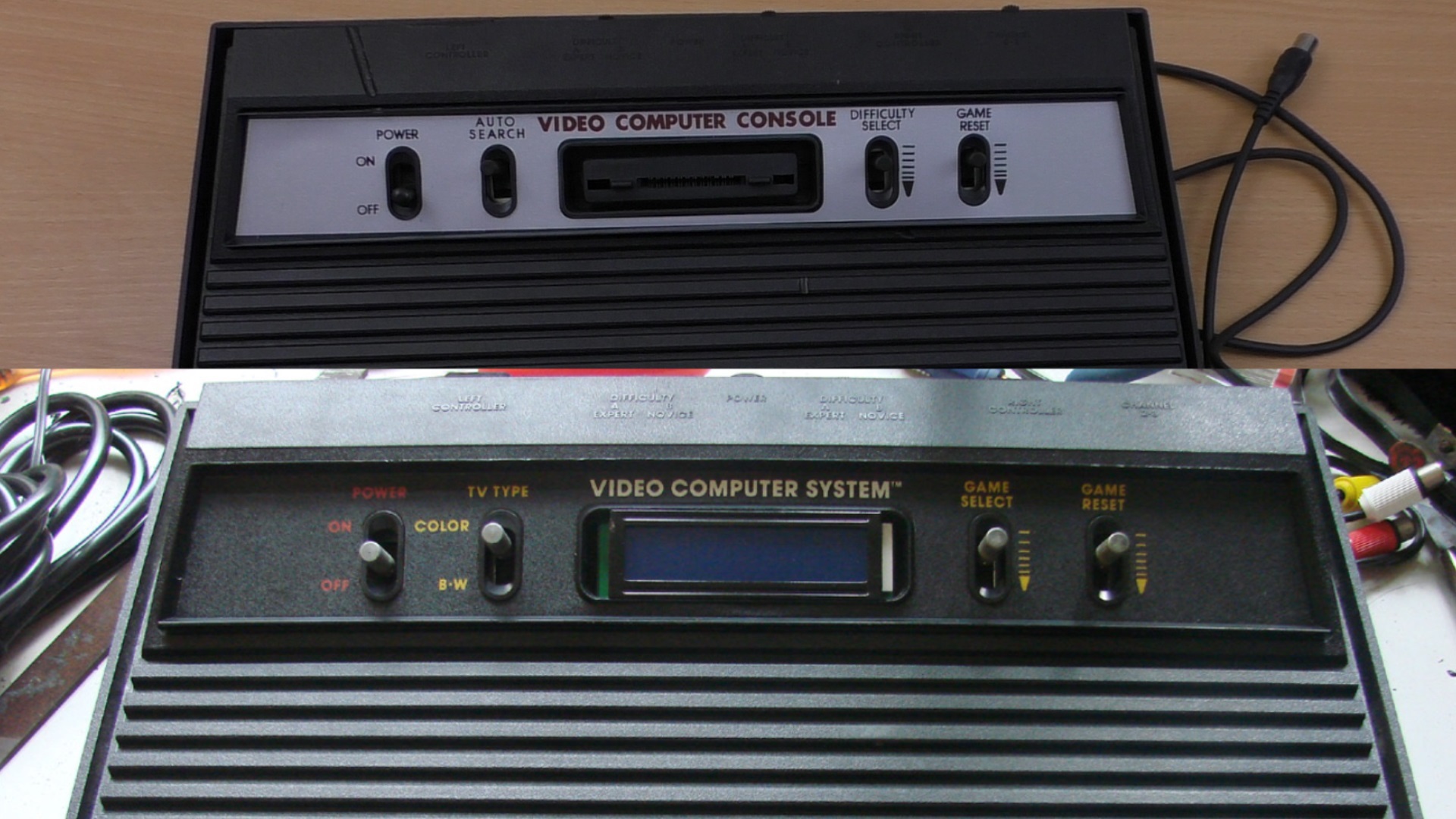
The first in the series, as on the original console, is a power switch. No surprises pushed comfortably. The remaining three are not switches, but spring-loaded levers - they report their push to the game or the console itself, after which they automatically return to their original position. The fourth switch, Game Reset , as we see, is also identical to the original. But the remaining two switches have different signatures.
Game Select, for example, turned into a Difficulty Select , although the original name was more correct, because it often switches not only complexity, but also the very essence of the game, its mode. For example, he can switch between modes for one or two players.
The same color switch was replaced with a built-in game switch; its use launches the next game in the list. Moreover, the switch goes only "forward", i.e. To select 32 games in the list - you need to click the switch 32 times. Did you miss the right game? Excuse me to start from the very beginning or go further through the looped list. Tin.
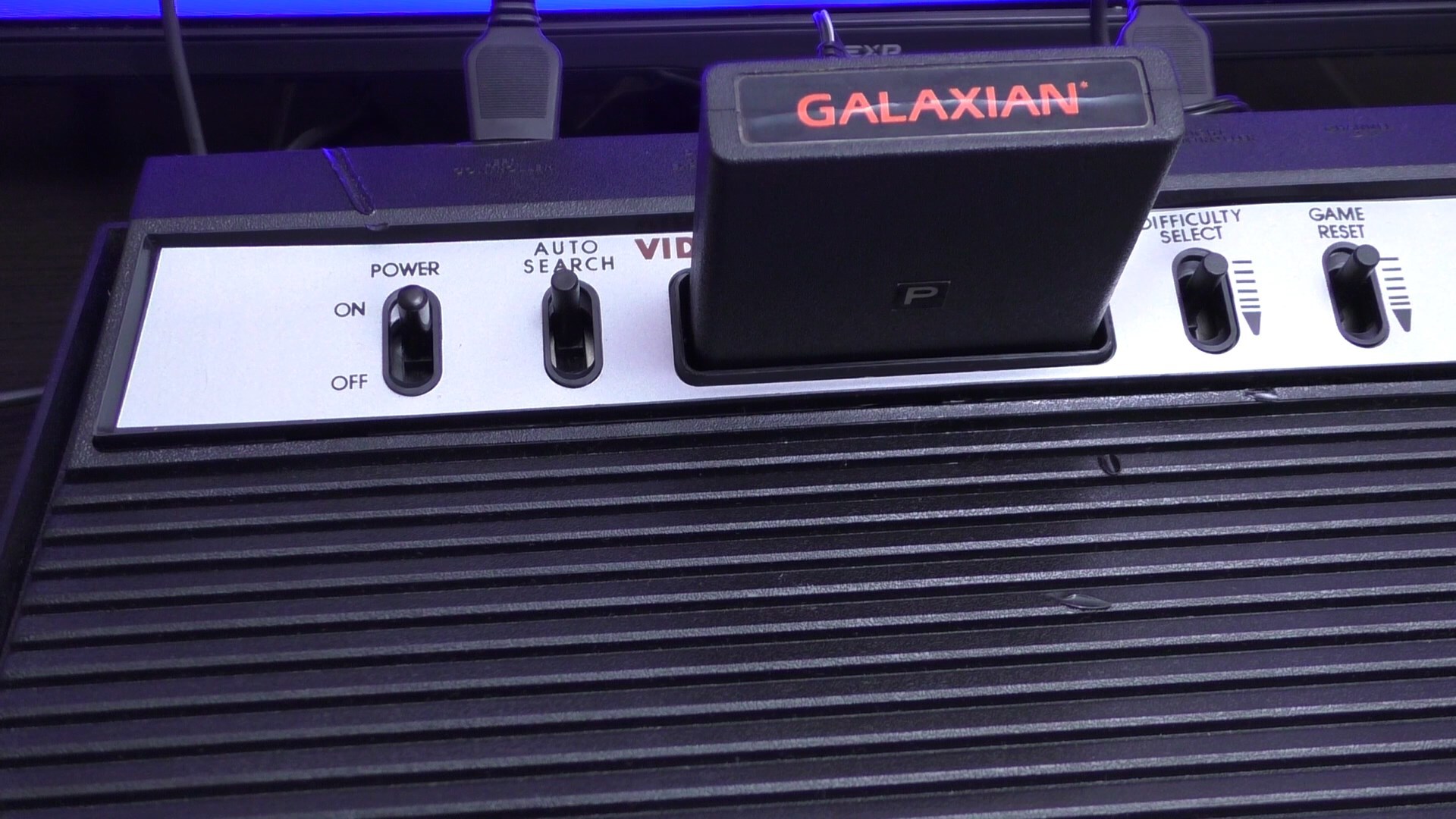
In addition, with this switch and the original there was a funny nuance. He did not change anything in the console, did not force her to customize the palette or something like that. No, the switch was simply reported to the toy - “the user has put the switch in this position”. And the toy programmer had to write the code himself, which somehow reacted to it, changed colors to more contrast ones or something like that.
The specificity of the situation is that not all programmers paid attention to this, i.e. not all games had a specialized black and white mode. Moreover, there was a small set of games that used this switch not for changing colors, but for something more meaningful, affecting the gameplay - well, there’s a type that would turn on the protective field or engine. In short, in these games this switch was used as an additional button, so playing these games on this clone you will lose some features of these games, which is good.
On top of the console there are two difficulty switches. Sometimes they affect the first and second players separately, sometimes they affect some global game modes, and it is not always obvious - it all depends on the particular toy, so without documentation there’s no hands.
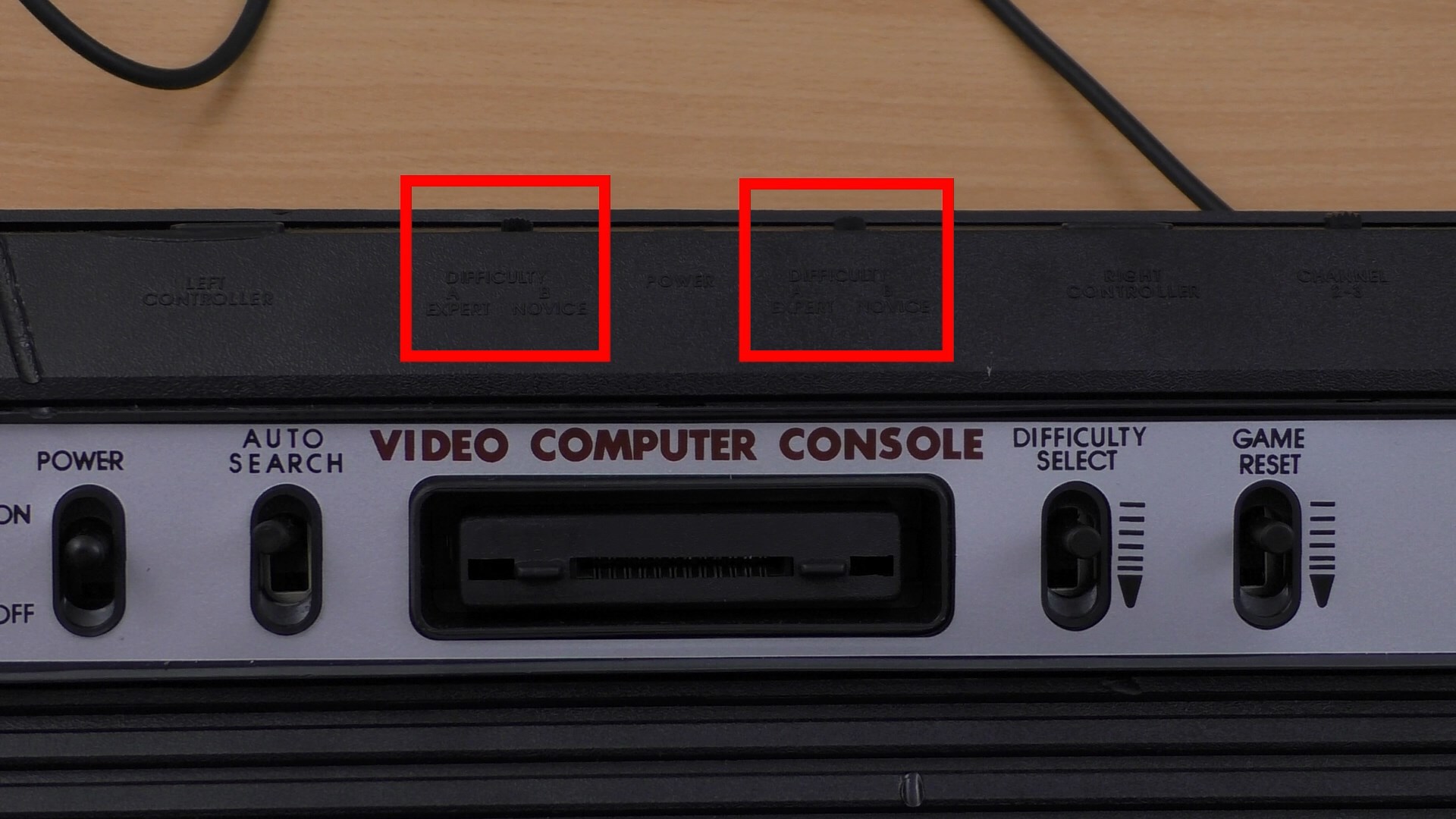
There is also a channel switch. In the original console, it influenced the frequency at which a signal would be sent across the antenna cable. In the clone, he switches banks with games; chose a different value - got a different set of built-in games.
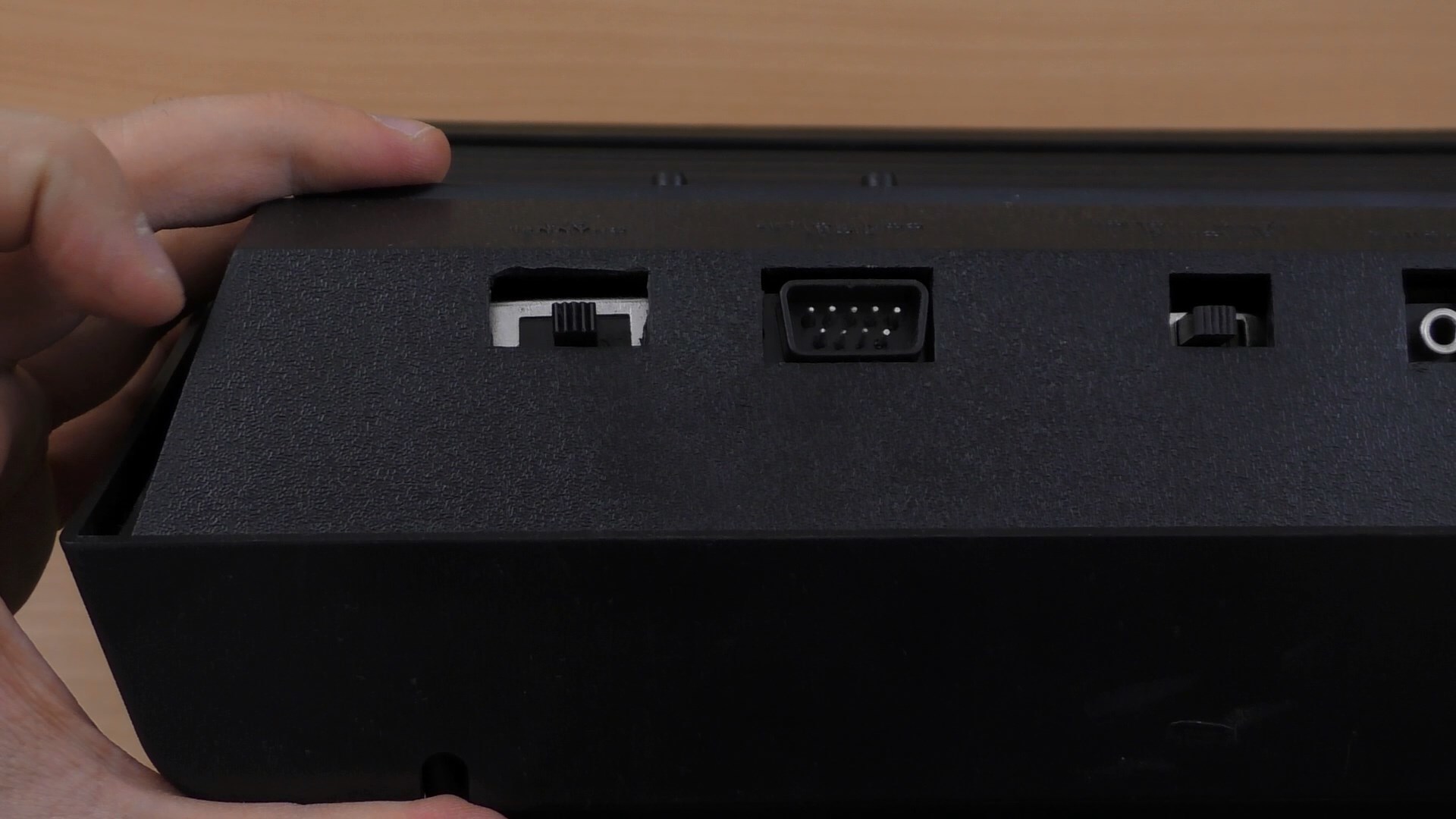
True, this only applies to versions with 48 games or more. There are only 32 games in my clone, so this switch makes it absolutely nothing.
Cartridges for the console look like this - very small, very light, with a cool printing in front and an almost complete absence of marks on the other faces except the bottom ... or the top, depending on how you look at them. They are stuck and poked without much effort, although when pulling out, it is often necessary to hold the console itself, for they sit very tightly in the slot.

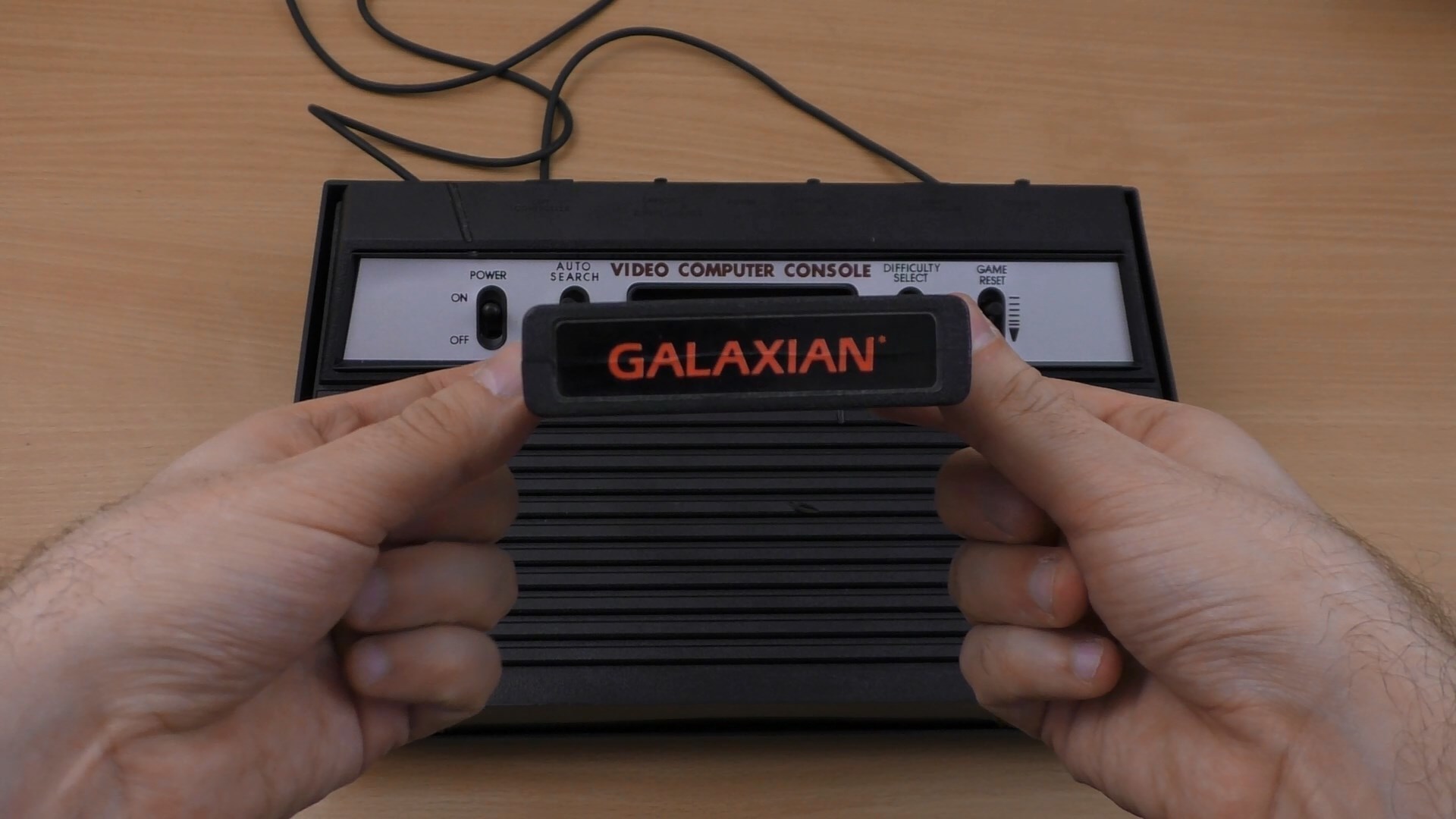
If you look at the console from the back, we will see the switches already mentioned, the ports for the joysticks, as well as the port for connecting the power supply. In short, no surprises.
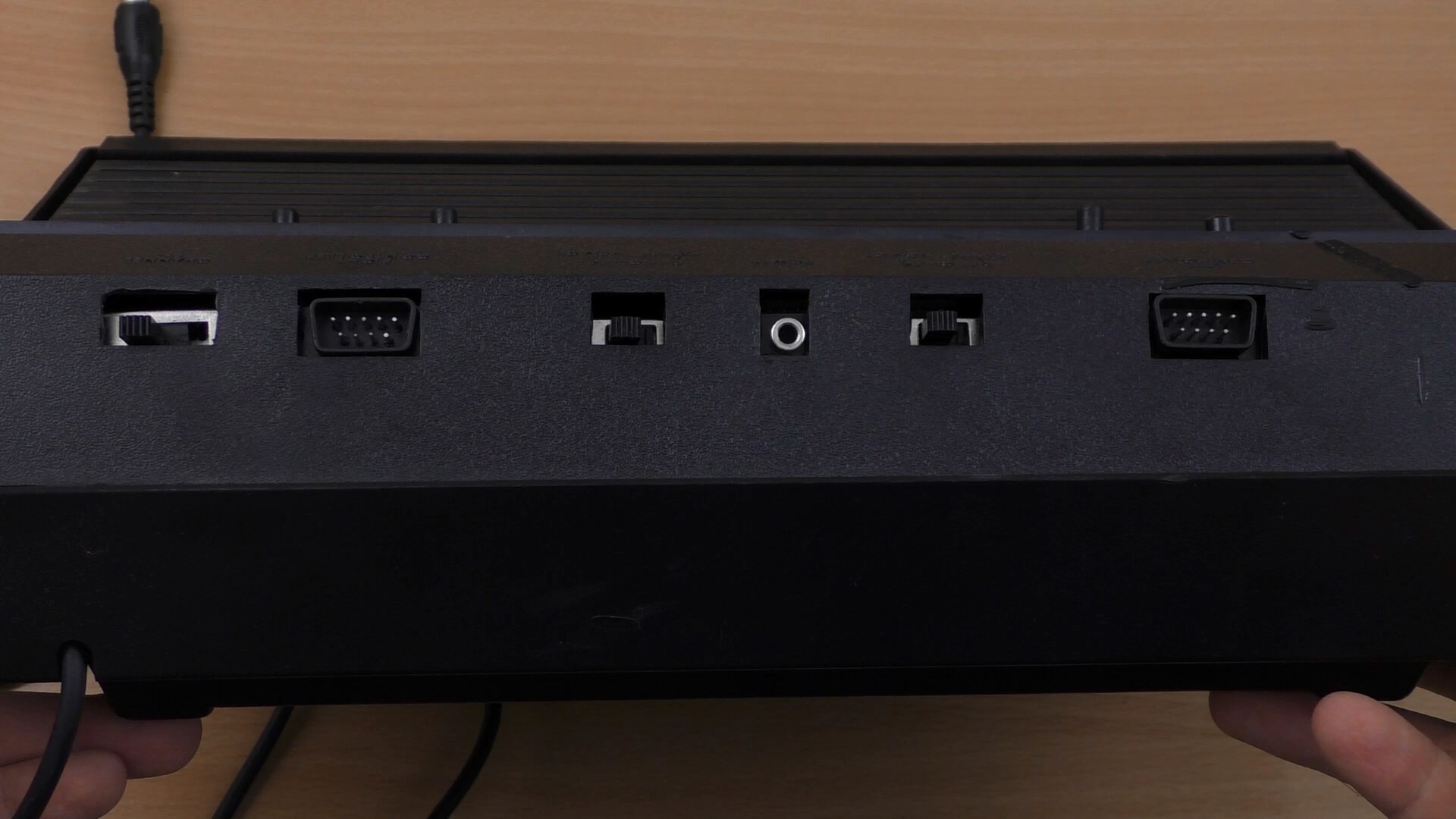
Just behind the bottom of the console comes out like a fixed cable for connection through the antenna input of the TV. However, for straight-handed people with a soldering iron, there is a modification instruction that allows you to get a full-fledged composite output from the console, and with it - some better picture quality, which was already told at Geektimes .

The board at the console is very, very small, the case, if desired, could be two or three times smaller. At the same time, judging by the pictures, the original console in terms of dimensions was about the same, with the difference that the original was assembled on several more chips.

Above you can see a compound embedded chip with embedded games, which, however, is not surprising.

But what is a little surprising is the fact that the antenna cable turns out to be very replaceable here! It would seem, what prevented to pull this connector out and simplify the replacement of the cable? Well, most likely the fact that the clone makers wanted the look to be as original as possible.

Now about connecting to TV. For me personally, no matter how funny it was, the most important connection quest was to find the right menu in the TV menu that triggers the search for the frequency of the signal at the antenna input. Well, yes, the last time I used a television antenna 10 years ago, if not more ... As is typical, the signal was found even faster than I found the necessary option in the menu.
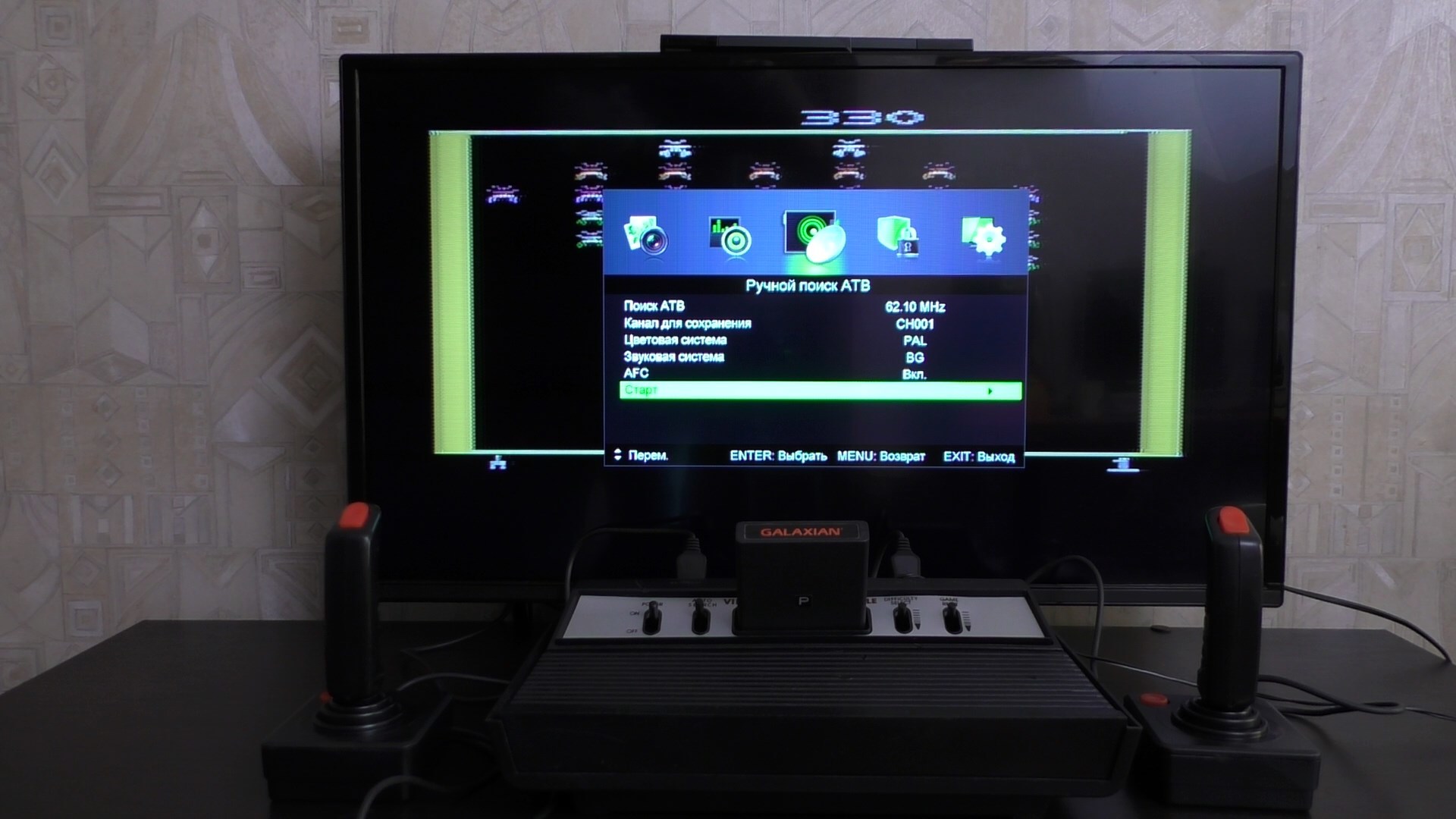
But the next few times after setting up it is enough to turn on the power - and the game immediately starts in demo mode, without long downloads and logos. It is curious that many games on Atari in the demo mode do not make a sound at all or make some kind of left noise, so you can only check if everything is set up correctly by running the game.

Speaking of the joysticks of this clone: they are not very easy to handle, have a very small move. In theory, instead of these joysticks, you can use gamepads from Megadrive, but for some reason I was caught up in this field with a fiasco: the crosspiece only works when I simultaneously hold down the shooting button, and the movement is ragged, not smooth. Perhaps, the authors of a particular joystick were very nasty, because I took it from the megadrive-clone, and not from the original.

Now about the games. The port for cartridges is working here, although I checked it only on one game - there are simply no others in the collection. The quality of the signal through the antenna is very unimportant, and also varies from game to game: somewhere tolerable, somewhere complete hell. However, in the screenshots it is not very noticeable. But you can see that the game is rarely uses the entire screen area vertically
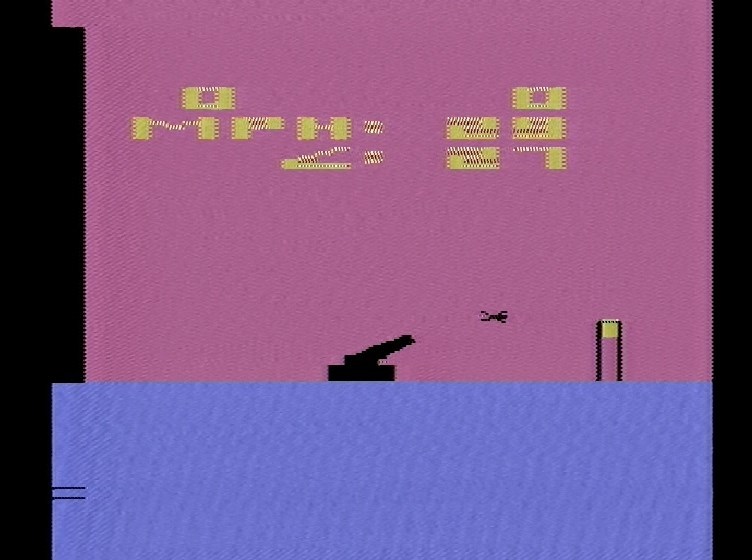
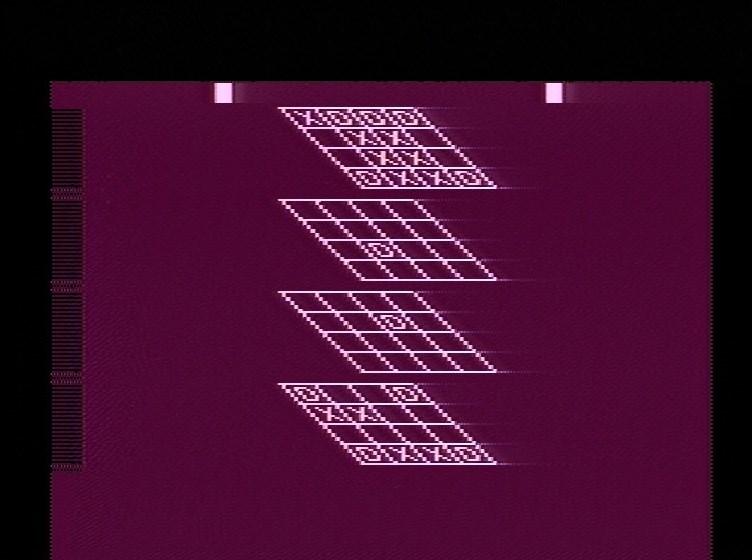


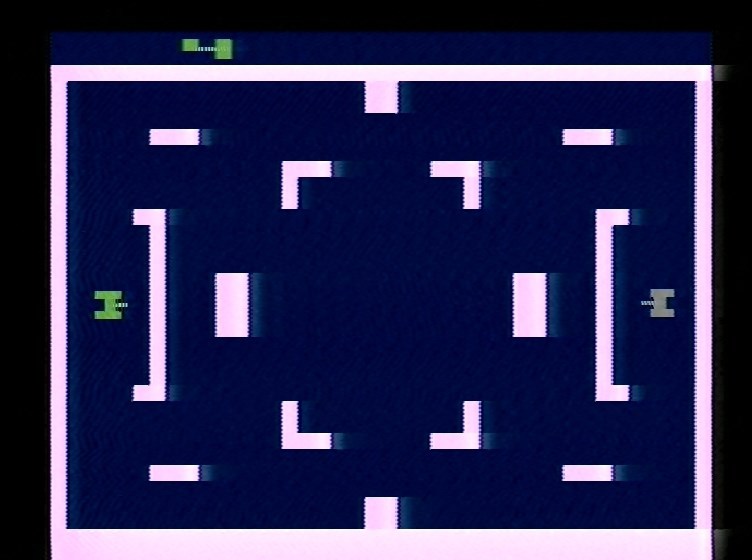
So I note an interesting fact: some games are started by pressing the joystick button, the other part is ignored by this button and started with the reset lever.
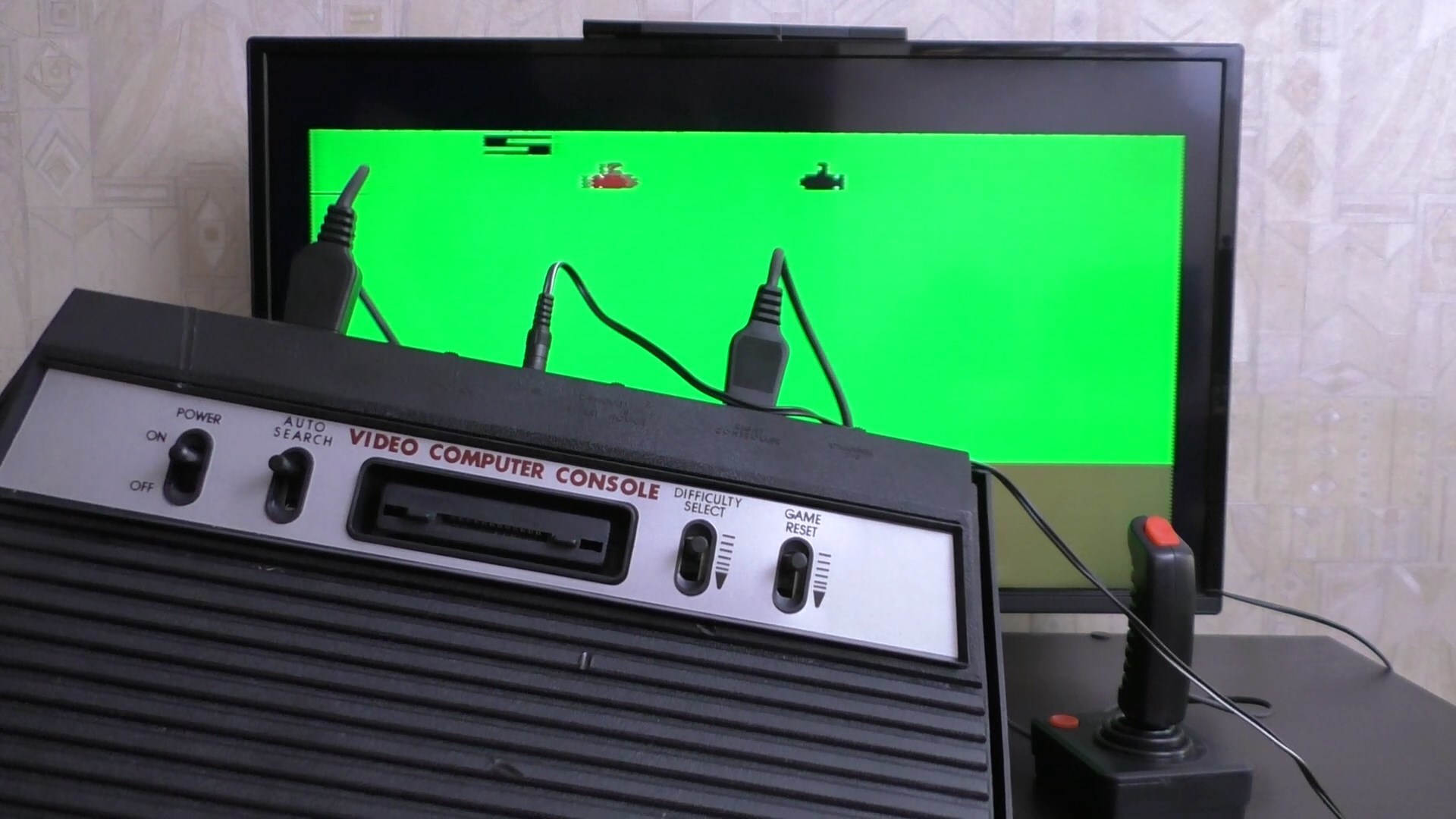
The list of built-in games changed from version to version of this clone, and began with 32 games, and ended with more than 96. My list corresponds to this branded Atari 32 in 1 cartridge released in 1988. As you can see from the link, the set of games is very “so-so”, practically no classics. In addition, the actual games are not 32, but only 30 - two pairs of games are completely identical, differing only in graphics.

Well, this is probably all important. If you want to know a little more details, as well as see a brief overview of all 32 built-in games - then here is my video, which became the basis for this article.
In 1982, the next edition was released, with which the console received the more popular name today - Atari 2600 . However, in our country, the acquaintance with this console most likely happened not with one of the original versions, but with the Taiwanese Rambo clone. We will talk about him today ...

')
Briefly about the main characteristics of the console ... About which you probably have already heard dozens of times. But for the pro forma it is necessary to list, but what is the article about retro-iron without tsiferok?
- CPU: MOS 6507 (1.19 MHz)
- RAM: 128 bytes (seriously, 128 BYTE )
- Cartridge capacity: 4 to 32 kilobytes
As you can see, the list lacks such a thing as video memory. It's all about a fairly specific graphics chip device, about which, if desired, you can write a separate article ... In any case, programming for such restrictions is also a task.
This is enough theory - go to the practice. The console box is huge, I would even say gigantic, it is almost the same size as the Power Macintosh, which I mentioned earlier . Fortunately, despite its size, it weighs much less.


On the top cover of the box you can see the joyful inscription "2600 built-in games", which, of course, is full of bullshit. In addition, none of the games on the cover in this console is not built, but more on that later.

The contents of the box traditionally begin with the documentation. Here it is represented by exactly one A4 sheet, where all the necessary things are indicated in two languages - English and Arabic.


The next thing in the box is the power supply. A rather typical unit, although I personally was a little surprised by the connector, made in the shape of a 3.5 mm jack. Of course, I heard about this, but I never saw it live.


Next comes a pair of joysticks, and personally only one of them worked normally for me, the second one has contacts that go around, and there are purely mechanical damage inside. It is curious that the standard Atari joystick had only one button, on the base, this one has two of them at once. These two buttons duplicate each other, but I want to pay tribute to the Chinese - in my opinion, pushing the handle button is much more convenient than the button at the bottom. However, everything is to your taste - both buttons are pressed well.


If you disassemble the joystick, you can find that it is not analog, but discrete, i.e. does not measure the force of deflection in any direction. Contact or is, or not, without variations and intermediate values. Original joysticks work similarly, except that they are assembled with higher quality.

The next thing in the box is the antenna input splitter. We need it in order to plug into the TV at the same time and the console, and the usual antenna, getting the opportunity to switch between them, without pulling the antenna cable back and forth. This switch is purely mechanical, simply closing the desired pair of connectors

Well, now - the console itself.

This console, like its box, is very large, compared to it, the late edition of PlayStation One is just a little one. By the way, I already shot a separate video about the first PlayStation. As well as about the PlayStation 2, but she’s definitely not to do with it at all ...

At first glance, the console is very much like the original, and not at the earliest, but at a later and more familiar version of the console. But there are a number of differences. Firstly, of course, there are no Atari logos, and a different inscription is used, instead of the Video Computer System, we see the Video Computer Console - it seems to be enough to be confused.


Secondly, reddish and switches. From above - a clone, from below - the original.

The first in the series, as on the original console, is a power switch. No surprises pushed comfortably. The remaining three are not switches, but spring-loaded levers - they report their push to the game or the console itself, after which they automatically return to their original position. The fourth switch, Game Reset , as we see, is also identical to the original. But the remaining two switches have different signatures.
Game Select, for example, turned into a Difficulty Select , although the original name was more correct, because it often switches not only complexity, but also the very essence of the game, its mode. For example, he can switch between modes for one or two players.
The same color switch was replaced with a built-in game switch; its use launches the next game in the list. Moreover, the switch goes only "forward", i.e. To select 32 games in the list - you need to click the switch 32 times. Did you miss the right game? Excuse me to start from the very beginning or go further through the looped list. Tin.

In addition, with this switch and the original there was a funny nuance. He did not change anything in the console, did not force her to customize the palette or something like that. No, the switch was simply reported to the toy - “the user has put the switch in this position”. And the toy programmer had to write the code himself, which somehow reacted to it, changed colors to more contrast ones or something like that.
The specificity of the situation is that not all programmers paid attention to this, i.e. not all games had a specialized black and white mode. Moreover, there was a small set of games that used this switch not for changing colors, but for something more meaningful, affecting the gameplay - well, there’s a type that would turn on the protective field or engine. In short, in these games this switch was used as an additional button, so playing these games on this clone you will lose some features of these games, which is good.
On top of the console there are two difficulty switches. Sometimes they affect the first and second players separately, sometimes they affect some global game modes, and it is not always obvious - it all depends on the particular toy, so without documentation there’s no hands.

There is also a channel switch. In the original console, it influenced the frequency at which a signal would be sent across the antenna cable. In the clone, he switches banks with games; chose a different value - got a different set of built-in games.

True, this only applies to versions with 48 games or more. There are only 32 games in my clone, so this switch makes it absolutely nothing.
Cartridges for the console look like this - very small, very light, with a cool printing in front and an almost complete absence of marks on the other faces except the bottom ... or the top, depending on how you look at them. They are stuck and poked without much effort, although when pulling out, it is often necessary to hold the console itself, for they sit very tightly in the slot.


If you look at the console from the back, we will see the switches already mentioned, the ports for the joysticks, as well as the port for connecting the power supply. In short, no surprises.

Just behind the bottom of the console comes out like a fixed cable for connection through the antenna input of the TV. However, for straight-handed people with a soldering iron, there is a modification instruction that allows you to get a full-fledged composite output from the console, and with it - some better picture quality, which was already told at Geektimes .

The board at the console is very, very small, the case, if desired, could be two or three times smaller. At the same time, judging by the pictures, the original console in terms of dimensions was about the same, with the difference that the original was assembled on several more chips.

Above you can see a compound embedded chip with embedded games, which, however, is not surprising.

But what is a little surprising is the fact that the antenna cable turns out to be very replaceable here! It would seem, what prevented to pull this connector out and simplify the replacement of the cable? Well, most likely the fact that the clone makers wanted the look to be as original as possible.

Now about connecting to TV. For me personally, no matter how funny it was, the most important connection quest was to find the right menu in the TV menu that triggers the search for the frequency of the signal at the antenna input. Well, yes, the last time I used a television antenna 10 years ago, if not more ... As is typical, the signal was found even faster than I found the necessary option in the menu.

But the next few times after setting up it is enough to turn on the power - and the game immediately starts in demo mode, without long downloads and logos. It is curious that many games on Atari in the demo mode do not make a sound at all or make some kind of left noise, so you can only check if everything is set up correctly by running the game.

Speaking of the joysticks of this clone: they are not very easy to handle, have a very small move. In theory, instead of these joysticks, you can use gamepads from Megadrive, but for some reason I was caught up in this field with a fiasco: the crosspiece only works when I simultaneously hold down the shooting button, and the movement is ragged, not smooth. Perhaps, the authors of a particular joystick were very nasty, because I took it from the megadrive-clone, and not from the original.

Now about the games. The port for cartridges is working here, although I checked it only on one game - there are simply no others in the collection. The quality of the signal through the antenna is very unimportant, and also varies from game to game: somewhere tolerable, somewhere complete hell. However, in the screenshots it is not very noticeable. But you can see that the game is rarely uses the entire screen area vertically





So I note an interesting fact: some games are started by pressing the joystick button, the other part is ignored by this button and started with the reset lever.

The list of built-in games changed from version to version of this clone, and began with 32 games, and ended with more than 96. My list corresponds to this branded Atari 32 in 1 cartridge released in 1988. As you can see from the link, the set of games is very “so-so”, practically no classics. In addition, the actual games are not 32, but only 30 - two pairs of games are completely identical, differing only in graphics.

Well, this is probably all important. If you want to know a little more details, as well as see a brief overview of all 32 built-in games - then here is my video, which became the basis for this article.
Source: https://habr.com/ru/post/402005/
All Articles